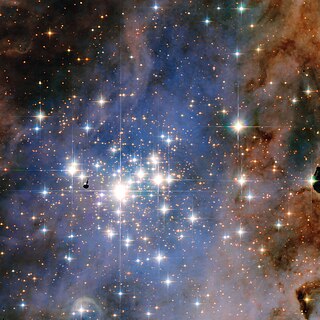This page is based on this
Wikipedia article Text is available under the
CC BY-SA 4.0 license; additional terms may apply.
Images, videos and audio are available under their respective licenses.

The Carina Nebula is a large, complex area of bright and dark nebulosity in the constellation Carina, and is located in the Carina–Sagittarius Arm. The nebula lies at an estimated distance between 6,500 and 10,000 light-years from Earth.

Iota Carinae, also named Aspidiske, is a star in the southern circumpolar constellation of Carina. With an apparent visual magnitude of 2.2, it is one of the brighter stars in the night sky. It can be seen from the latitude of Alexandria or Mobile, Alabama and southward.

Luminous blue variables (LBVs) are massive evolved stars that show unpredictable and sometimes dramatic variations in both their spectra and brightness. They are also known as S Doradus variables after S Doradus, one of the brightest stars of the Large Magellanic Cloud. They are extraordinarily rare with just 20 objects listed in the General Catalogue of Variable Stars as SDor, and a number of these are no longer considered to be LBVs.

Epsilon Carinae, also named Avior, is a binary star in the southern constellation of Carina. At apparent magnitude +1.86 it is one of the brightest stars in the night sky, but is not visible from the northern hemisphere. The False Cross is an asterism formed of Delta Velorum, Kappa Velorum, Iota Carinae and ε Carinae. It is so called because it is sometimes mistaken for the Southern Cross, causing errors in astronavigation.
V337 Carinae is a K-type bright giant star in the constellation of Carina. It is an irregular variable and has an apparent visual magnitude which varies between 3.36 and 3.44.

V382 Carinae, also known as x Carinae, is a yellow hypergiant in the constellation Carina. It is a G-type star with a mean apparent magnitude of +3.93, and a variable star of low amplitude.

HD 93129 is a triple star system in the Carina Nebula, with all three components being hot O class stars amongst the most luminous stars in the Milky Way. It is the dominant member of the Trumpler 14 star cluster, a young star cluster within the Carina OB1 stellar association that harbors other super luminous stars, like Eta Carinae and WR 25.

V518 Carinae is a naked-eye variable star in the constellation Carina. It is a member of the bright open cluster IC 2602 near the Carina Nebula.
The Bayer designations e Carinae and E Carinae are distinct and the designation e Carinae is shared by two stars in the constellation Carina:
The Bayer designations b Carinae and B Carinae are distinct and the designation b Carinae is shared by two stars in the constellation Carina:
The Bayer designations g Carinae and G Carinae are distinct.
The Bayer designations h Carinae and H Carinae are distinct.

BO Carinae is a variable star in the constellation Carina.
The Bayer designations q Carinae and Q Carinae are distinct.
The Bayer designations i Carinae and I Carinae are distinct.
The Bayer designations c Carinae and C Carinae are distinct.
The Bayer designations k Carinae and K Carinae are distinct.
The Bayer designations m Carinae and M Carinae are distinct.
The Bayer designations S Carinae and s Carinae are distinct. Due to technical limitations, both designations link here. For the star
The Bayer designations U Carinae and u Carinae are distinct. Due to technical limitations, both designations link here. For the star




